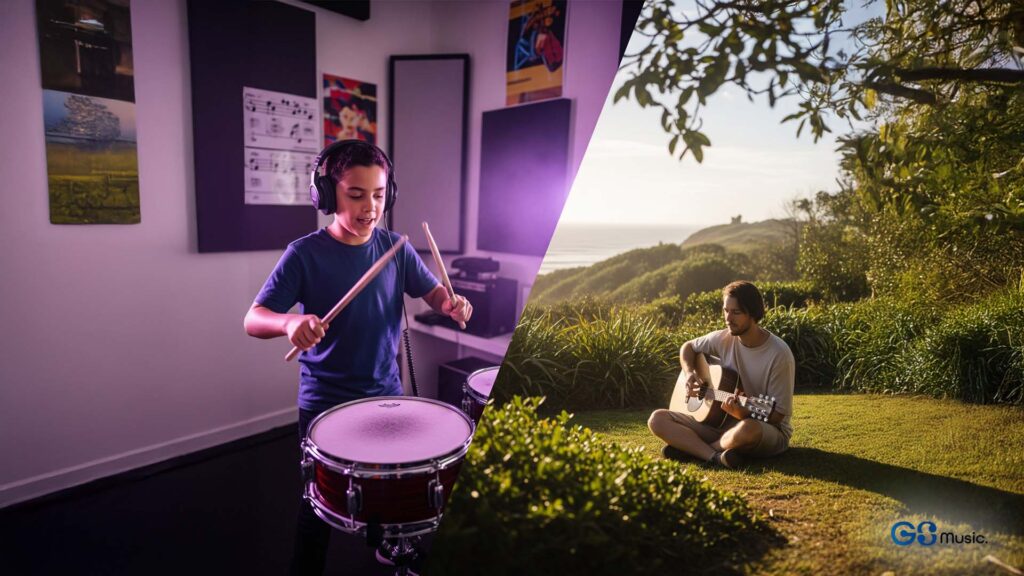Drum vs Guitar: Which Path to Musicality Is Easier?
For aspiring musicians, choosing between the rhythmic pulse of drums and the melodic range of the guitar can be a tough call. Both instruments offer immense creative rewards, but their learning curves, skill demands, and long-term growth differ significantly. Neither is inherently “easy” to master, yet the journey to proficiency varies based on your natural strengths and musical goals.

The Allure and Initial Hurdles
Drums: The Rhythmic Foundation
Drumming can seem straightforward—hit a surface, hear a sound. Beginners often experience quick wins; within a few lessons, you might play a basic rock beat and jam along to a favorite song. This instant gratification is a big motivator.
However, the challenge lies in coordination. Drumming requires independent limb control—your hands and feet must work together on separate rhythms. Mastering this four-way coordination takes focus, stamina, and precise timing, as even small inconsistencies can disrupt a groove.
At GS Music Lessons in Noosa, we emphasize muscle memory and timing to help students build confidence steadily.

Guitar: The Melodic Storyteller
The guitar, by contrast, demands precision from the start. Producing a clean note requires exact finger placement and a light touch, which can be tricky for beginners. Sore fingers are common as calluses develop, but once you master a few chords, the instrument opens up.
Many students find themselves strumming recognizable tunes within 3–4 weeks of consistent practice, especially with structured guidance. The guitar’s appeal also lies in its songwriting potential, making it a favorite for creative learners.
The Learning Curve: A Deeper Dive
Drums: Gradual Mastery Through Repetition

Drums provide early successes, but advanced skills take time. Complex rhythms, polyrhythms, and dynamics require years of disciplined practice—some drummers report 6–12 months to feel comfortable with intermediate patterns.
Group play can accelerate growth by sharpening timing and listening skills—an approach we prioritize in our programs.
Guitar: Fast Start, Then Focused Growth
The guitar’s learning curve is steeper initially but levels out. After mastering basic chords, progress comes from adding techniques like fingerpicking or soloing.
Studies suggest guitarists often reach a “playable” stage for simple songs within 1–2 months of daily practice, with growth becoming more gradual as they explore music theory and advanced styles.

Music Theory: A Matter of Focus

Rhythm vs. Harmony
- Drummers focus on rhythm theory—time signatures, subdivisions, and syncopation.
- Guitarists dive into harmonic theory—scales, chords, and progressions.
At GS Music Lessons, we make both paths fun and accessible:
- For drummers: Visual, interactive rhythm training
- For guitarists: Bite-sized theory integrated with real songs
Practical Considerations: Budget, Volume, and Opportunities
Cost
- Beginner guitar: ~$150–$200
- Acoustic drum kit: ~$500+
- Electronic drum kit: Quieter and more budget-friendly
- GS Music offers rental options to ease the initial investment
Noise
- Drums are louder, though electronic kits with headphones help
- Guitars are quieter and more neighbor-friendly
Demand
Skilled drummers are highly sought-after in bands due to their relative rarity compared to guitarists. Both instruments offer solo and group opportunities, but drummers may find ensemble placement more accessible.
The Sunshine Coast Advantage: Learning Locally
Understanding the instrument is just the beginning—getting the right support is key.
Why Choose GS Music Lessons?
- Personalized Coaching – We adapt to your pace and learning style
- Confidence-Building – Encouraging feedback that builds musical fluency
- Creative Focus – Nurturing your songwriting and improvisation
- Flexible Scheduling – Lessons that fit your lifestyle in Noosa, Coolum, and Peregian
Our Programs
🥁 Drum Lessons
Build rhythm, coordination, and groove with guided hands-on sessions and play-alongs.
🎸 Guitar Lessons
Start with chords and strumming, then evolve into melody, fingerstyle, and songwriting.
Final Thoughts: Passion Over “Ease”
So, which instrument is easier? It depends on you.
- If rhythm and energy move you—try drums
- If melody and emotion call to you—go for guitar
At GS Music, we offer a trial lessons so you can explore both and find what resonates.
Start Your Journey Today
✅ Trial Lessons Available
✅ Beginner-Friendly Classes for All Ages
✅ Flexible Times in Noosa & Local Schools
✅ Expert Tutors for Drums and Guitar
🎵 Learn more or book your lesson now:
👉 gsmusiclessons.com.au
